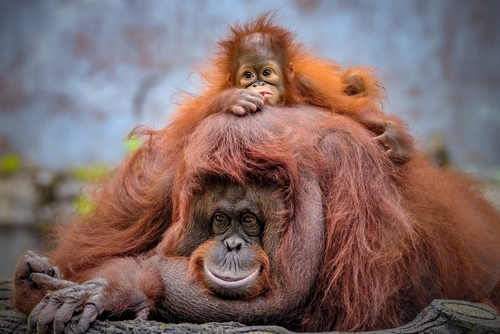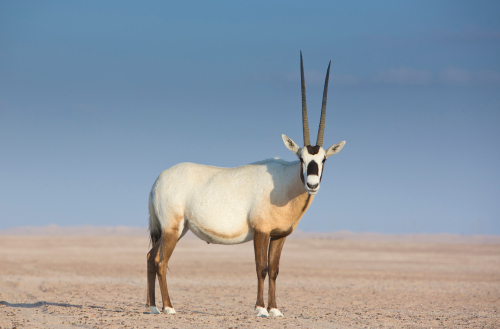8 Zoos Helping Animals Edge Out of Extinction
Updated on May 24, 2024

All featured products are chosen at the discretion of the Vetstreet editorial team and do not reflect a direct endorsement by the author. However, Vetstreet may make a small affiliate commission if you click through and make a purchase.
At the zoo, you get to spy creatures that you’d otherwise never see.
But zoos are more than just fun places to visit — without their dedicated conservation efforts, some animals would be lost to us forever.
These eight zoos across the country have been instrumental in saving certain animal species from the brink of extinction.
Phoenix Zoo: Arabian Oryx

The Arabian oryx was long hunted in the deserts of the Arabian Peninsula, but with the introduction of more effective modern hunting techniques, their numbers began to decline considerably in the mid-20th century. In 1962 an expedition to capture three of the last remaining oryx helped to start a breeding program at the Phoenix Zoo in Arizona.
In 1972 the species was declared extinct in the wild, but the first captive-bred animals were released back into their natural habitat in 1981 — and now there are over 1,000 of them in the wild.
Operation Oryx was one of the earliest efforts to save a species from extinction, and according to Stuart Wells, director of conservation and science for the zoo, the first to reach one major milestone: In 2011 their conservation status improved from “endangered” to “threatened,” which is the first time that this has happened to a species previously declared extinct.
National Zoo: Golden Lion Tamarin
These striking little orange monkeys are threatened by the destruction and fragmentation of their Brazilian rainforest habitat.
In 2003, due to successful captive breeding and reintroduction, their status improved from “critically endangered” to “endangered.”
Some of the captive-bred critters got practice living relatively “wild” in a program hosted at the National Zoo in Washington, D.C., where they had free range of the grounds in the summer.
Lincoln Park Zoo: Puerto Rican Parrot
In 1975 the wild population of the Puerto Rican parrot was down to just 13 birds.
Part of the problem is that the parrots are particularly vulnerable to hurricanes: When careful protection had the wild population up to 47 in 1989, more than half were wiped out by Hurricane Hugo.
Today, thanks to the efforts of zoo scientists at the Lincoln Park Zoo in Chicago, captive-bred birds at two aviaries number over 200 — and reintroduction is underway. Some 60 wild and captive-born Puerto Rican parrots now live free.
Columbus Zoo: Freshwater Mussels
It’s not just cuddly and feathered animals that need our help: Freshwater mussels are threatened by habitat loss, pollution and competition from invasive species, which is why some of these mollusks are on the federal endangered species list.
The Columbus Zoo in Ohio has a facility dedicated to propagating mussels — and has released thousands of the mollusks, which are even tagged with transponders for tracking in the wild.

Cheyenne Mountain Zoo: Black-Footed Ferret
The black-footed ferret was believed to be extinct in 1979, until a small population was found in Wyoming in 1981. But the good news didn’t last long: Their numbers began to decline rapidly due to disease, so the remaining ferrets were captured to begin a breeding program.
In 1991, captive-bred ferrets were released into the wild — and they’ve since been successfully reintroduced in at least four locations that were part of the species’ original range.
One participant in the breeding program, the Cheyenne Mountain Zoo in Colorado, has released over 203 captive-born ferrets. Dr. Della Garelle, the zoo’s director of conservation, says that some are born with the aid of advanced technology, including artificial insemination using frozen semen to help preserve the species’ genetic diversity. “Ferrets that have been dead for 20 years have fathered young,” says Dr. Garelle.
San Diego Zoo: California Condor
Due to habitat destruction, poaching and even lead poisoning, only 22 California condors were left in the wild by the late 1980s.
So the remaining birds were brought into captivity to found a breeding program in conjunction with the San Diego Zoo in California. One novel technique that scientists used to breed the birds in captivity: condor hand puppets, which handlers wore to feed the baby birds.
In the early 1990s, conservationists began to release some of the California condors into the wild — and there are now over 200 flying free.
Toledo Zoo: Kihansi Spray Toad
The Kihansi spray toad wasn’t even discovered until a project put it at risk of extinction. In the 1990s, construction started on a dam in the Kihansi Gorge of Tanzania. Environmental surveys found the amphibian, which only existed across a four-hectare area in the spray zone of the waterfalls.
“The gorge was covered in cloud mist, and that was their habitat,” says Andy Odum, curator of herpetology at the Toledo Zoo in Ohio, which has been instrumental in saving the toads.
In 2000 several hundred toads were taken into captivity and sent to facilities in the U.S., including the Bronx Zoo in New York City. It was a good thing too, because the last toad was seen in the wild in 2004.
“A couple of years ago, we started to send animals back to Tanzania,” says Odum. “And the great news is that the first reintroduction experiments are going on. I’m very optimistic.”
National Zoo: Przewalski Horse
Once found widely across Europe and Asia, the Przewalski horse was declared extinct in the wild in 1970.
The National Zoo in Washington, D.C., participated in a program to breed the handful that remained in captivity, and in the 1990s, they were reintroduced to their native habitat in Mongolia.
Several hundred now survive in the wild — in 2008 they were reclassified from “extinct” to “critically endangered.”
Linda Lombardi is a former zookeeper, college professor and the author of Animals Behaving Badly, a book that grew from her blog of the same name.





